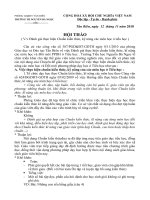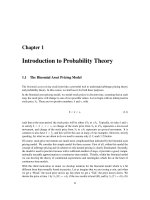Econ1001 day2 :Introduction to Microeconomics Day 2
Bạn đang xem bản rút gọn của tài liệu. Xem và tải ngay bản đầy đủ của tài liệu tại đây (428.17 KB, 51 trang )
Introduction to Microeconomics
Day 2
Professor Gordon MacAulay and
Dr Tran Van Hoa
T h e U n iv e r s ity o f S y d n e y
1
Supply and Demand Model
• Overview
– Define a demand curve
– Movements along and of the curve
– Define and supply curve
– Movements along and of the curve
– Supply and demand combined
– Price floors and ceilings
2
Supply Demand Model
• Supply and demand first described by
Alfred Marshall in 1890
• Model
– Demand
– Supply
– Market equilibrium
3
Demand
• Economists’ definition
– The relationship between the price of a
particular good and the quantity of the good
consumers are willing to buy at the price
during a specific time period all other things
equal (ie, ceteris paribus)
– Depends on many things but all the others are
held constant
4
Demand and Supply
Price ($/kg)
100
140
180
220
260
300
340
380
420
Demand
Supply
quantity
quantity
(kg/month) (kg/month)
36
2
28
8
22
14
18
18
14
22
10
26
6
30
4
32
2
34
• Demand
– Rice in a town stall
– Farmers supply to
the stall
– Equilibrium
5
Demand Relationship
Demand
Price ($/ kg)
– Slopes down
– Quantity is
negatively
related to
price
– Other things
constant
Demand Rela onship
450
400
350
300
250
200
150
100
50
0
y = 452.89e-0.042x
0
5
10
15
20
25
30
35
40
Quan ty demanded (kg/ month)
6
Demand Relationship
•
•
•
•
Demand relationship
y = -23.96ln(x) + 146.54
Shifted demand relationship
y = -23.96ln(x) + 160
7
Demand Relationship Shift
Demand Rela onship Shi
450
400
Price ($/ kg)
350
300
250
200
150
100
50
0
0
10
20
30
40
50
60
Quan ty demanded (kg/ month)
8
Demand Relationship Shift
• Many factors shift demand out or in
– Consumers’ preferences
– Consumers’ information
– Consumers’ incomes
– The number of consumers
– Consumers’ expectations of future prices
– Price of closely related goods.
9
Demand Relationship Shifts
• Income changes
– As income rises demand shifts out
• A normal good (eg cars, TVs, etc)
– As income rises demand shifts in
• An inferior good (maybe rice, potatoes, etc)
10
Demand Relationship Shifts
• Price of related goods
– Substitute
• Provides some of the same satisfaction
• As price of the other good rises demand shifts out
• For rice maybe corn is a substitute
– Complement
• Tend to be consumed together
• As price of the other good rises demand shifts in
• For example, coffee and sugar
11
Movements Along
Demand Rela onship
Price ($/ kg)
• Shifts of the
demand curve
are different
from
movements
along.
• Both price and
quantity
change
450
400
350
300
250
200
150
100
50
0
0
5
10
15
20
25
30
35
40
Quan ty demanded (kg/ month)
12
Supply Relationship
• The Economists’ definition
• A supply curve is a relationship between
the price of a particular good and the
quantity of the good that firms are willing
to sell at that price all other things the
same (ceteris paribus)
• Supply refers to the behaviour of
producers
13
Supply Relationship
• The law of supply:
– The higher the price the higher the quantity
supplied and the lower the price the smaller
the quantity supplied
• Supply relationship
• y = 23.023ln(x) - 105.21
14
Supply Relationship
Supply Rela onship
Price ($/ kg)
• Supply
is
positively
related
with price
450
400
350
300
250
200
150
100
50
0
0
5
10
15
20
25
30
35
40
Quan ty demanded (kg/ month)
15
Supply Relationship Shifts
• A number of factors cause a shift of the
supply relationship
– Technology
– The price of the inputs into production
– The number of firms in the market
– Expectations of future prices
– Government taxes, subsidies and regulations
• Tax increases costs so shifts to the left
• Subsidies increase profit so shift to the right
16
Movements Along and Shifts
• As in demand shifts of the function are
movements in or out
• Movements along are when prices and
quantities change together
17
Shift of the Supply Relationship
Supply Rela onship Shi
450
400
350
Price ($/ kg)
• Shift to the
right or left
occurs
when
factors
other than
price
change
300
250
200
150
100
50
0
0
10
20
30
40
50
60
Quan ty demanded (kg/ month)
18
Movement Along
Supply Rela onship
Price ($/ kg)
• Both
prices and
quantities
change
450
400
350
300
250
200
150
100
50
0
0
5
10
15
20
25
30
35
40
Quan ty demanded (kg/ month)
19
Market Equilibrium
• No single person or firm determines the
price in the market
• As buyers and sellers interact prices may
rise or they may fall. Why?
• To have an equilibrium prices need to be
free to change to the point where the
quantity demanded equals the quantity
supplied
20
Market Equilibrium
• When the
Price ($/kg)
quantity supplied
and the quantity
100
140
demanded are
180
equal there is a
220
260
market
300
340
equilibrium. In
380
420
this case a price
of $220/kg
Demand
Supply
Excess of
quantity
quantity
demand
(kg/month) (kg/month) over supply
36
28
22
18
14
10
6
4
2
2
8
14
18
22
26
30
32
34
34
20
8
0
-8
-16
-24
-28
-32
21
Market Equilibrium
• Equilibrium
– When there is a surplus of supply over
demand then price falls
– When there is an excess of demand over
supply then price rises
– Any price below $220 has an excess of
demand (price rises)
– Any price above $220 has an excess of
supply (price falls)
22
Market Equilibrium
Demand and Supply Equilibrium
450
400
350
Price ($/ kg)
• Marshallian
cross
• The model
can be
applied to
many
markets and
goods and
services
300
250
200
150
100
50
0
0
5
10
15
20
25
30
35
40
Quan ty demanded (kg/ month)
23
Supply and Demand Shift
Shi in the Demand and Supply
Equilibrium
450
400
350
Price ($/ kg)
• The
equilibrium
price moves
down from
$220 and 18
units to $205
and 32 units
demanded and
supplied
300
250
200
150
100
50
0
0
10
20
30
40
50
60
Quan ty demanded (kg/ month)
24
Supply and Demand Shift
• Shifts in supply and demand ceteris paribus
• In reality both supply and demand shift together
Change
Increase in demand
Decrease in demand
Increase in supply
Decrease in supply
Effect on
Effect on
equilibrium equilibrium
price
quantity
Up
Down
Down
Up
Up
Down
Up
Down
25
![[CEH V3] Introduction to Ethical Hacking](https://media.store123doc.com/images/document/13/ly/ap/medium_3ABUW8WdDH.jpg)








